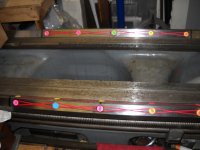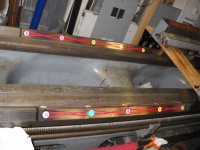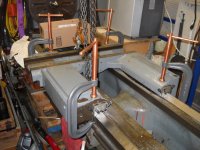4GSR
Diamond
- Joined
- Jan 25, 2005
- Location
- Victoria, Texas, USA
I like to share my experience using Moglice to repair the wear to the underside of a saddle to my 20" Model X Lodge & Shipley Gap Bed Lathe.
First thing I had to do was build some "levelers" to position the saddle on the bed so it is "square" and "level" or "parallel" to the bed. The levelers will also allow you to get the rack pinion in proper mesh with rack. This is assuming the bed is in good shape by re-grinding, planning, or scraping for proper alignment. In my case, the bed on my lathe was re-ground. Once this was done, you must determine how much gap there is between the bed ways and the saddle ways. In my case, about .045" max. The least was around .038".
From this I figured out how much cubic inches of area is needed to fill in to take up this gap. The measurements I came up with on my setup was .045" x 1.375" x 26" per way x 4 for a total of 6.435 cu. in. Next was to call the nice Moglice people, Devitt Machinery Co. and talk to their techinical advisory on what you are wanting to do. His recommendation to me was to use the "Putty Hard" for my application. He said I will need just a little under 350 grams of the stuff. Well that made me feel better that I didn't need to build up dams for the liquid stuff.
More write up to come....
[FONT=Open Sans, sans-serif]Edit:[/FONT]
[FONT=Open Sans, sans-serif]Ifyou go to Devitt Machinery Co. wedsite, and look at the downloads,there is a pdf file called “Machine Tool Way Rebuilding” Download it and take a look at it. Lots of good information on theapplication of Moglice.[/FONT]
First thing I had to do was build some "levelers" to position the saddle on the bed so it is "square" and "level" or "parallel" to the bed. The levelers will also allow you to get the rack pinion in proper mesh with rack. This is assuming the bed is in good shape by re-grinding, planning, or scraping for proper alignment. In my case, the bed on my lathe was re-ground. Once this was done, you must determine how much gap there is between the bed ways and the saddle ways. In my case, about .045" max. The least was around .038".
From this I figured out how much cubic inches of area is needed to fill in to take up this gap. The measurements I came up with on my setup was .045" x 1.375" x 26" per way x 4 for a total of 6.435 cu. in. Next was to call the nice Moglice people, Devitt Machinery Co. and talk to their techinical advisory on what you are wanting to do. His recommendation to me was to use the "Putty Hard" for my application. He said I will need just a little under 350 grams of the stuff. Well that made me feel better that I didn't need to build up dams for the liquid stuff.
More write up to come....
[FONT=Open Sans, sans-serif]Edit:[/FONT]
[FONT=Open Sans, sans-serif]Ifyou go to Devitt Machinery Co. wedsite, and look at the downloads,there is a pdf file called “Machine Tool Way Rebuilding” Download it and take a look at it. Lots of good information on theapplication of Moglice.[/FONT]
Attachments
Last edited:
























